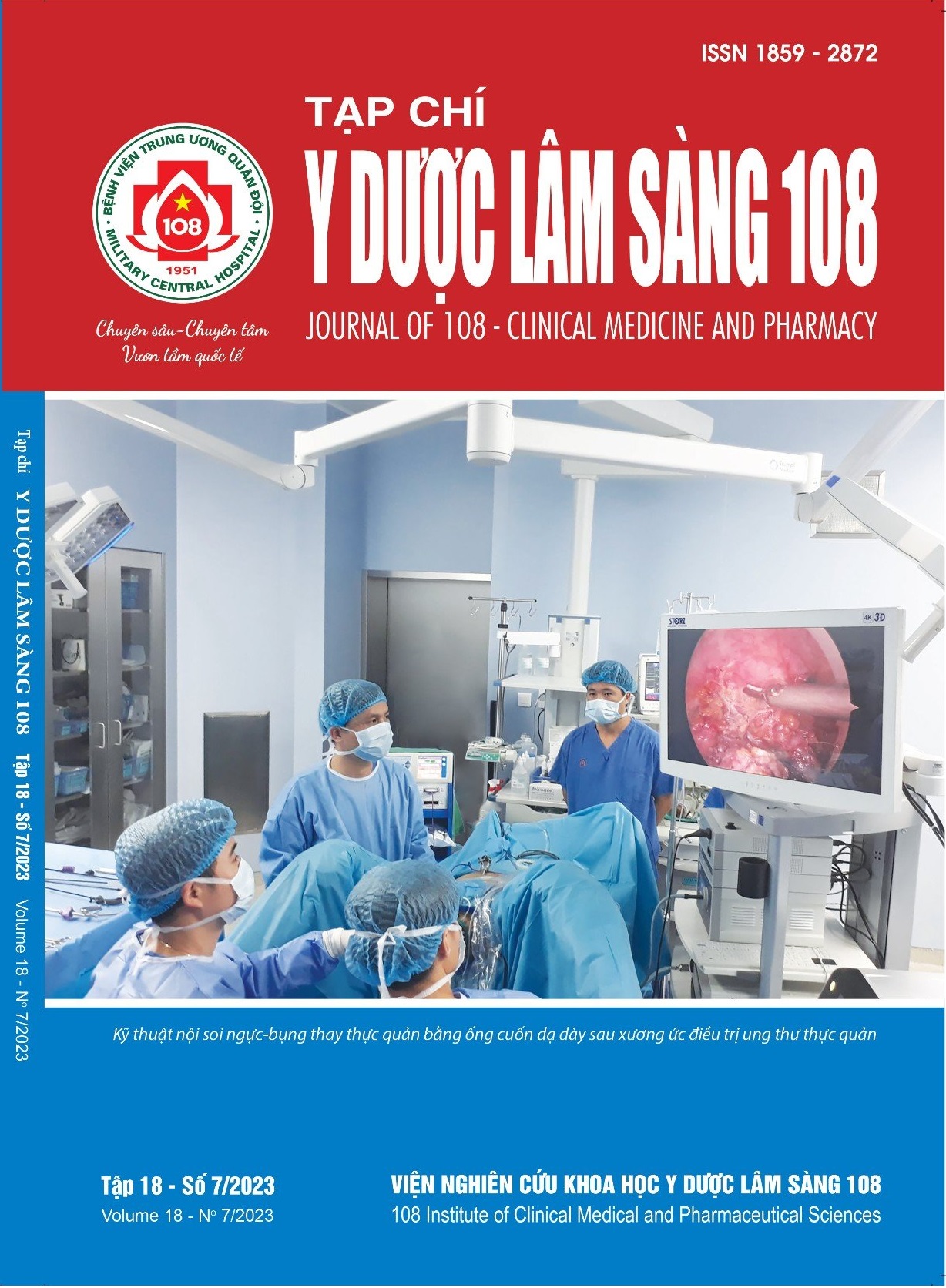Study of the prevalence, clinical and subclinical characteristics of non-alcoholic fatty liver disease in patients with lipid metabolism disorder at 175 Military Hospital
Main Article Content
Keywords
Abstract
Objective: To survey the prevalence and clinical, subclinical characteristics of non-alcoholic fatty liver disease in patients with lipid metabolism disorder at 175 Military Hospital. Subject and method: A retrospective and prospective study on 201 patients with lipid metabolism disorder who were examined at 175 Military Hospital from January 2019 to July 2020. Determining the prevalence of non-alcoholic fatty liver disease by fibroScan and clinical, subclinical characteristics in this group of diseases. Result: The female-to-male ratio was 1.16:1, with a mean age of 61.33 ± 11.22. The majority of patients were overweight or obese (61.19%), 54.23% had hypertension; 46.77% had type 2 diabetes. Most patients had no clinical symptoms of liver disease. Increased triglyceride level and serum GGT accounted for a high percentage (78.11% and 47.76%, respectively). The rate of non-alcoholic fatty liver disease in patients with lipid metabolism disorder was 80.60%, with mild (S1), moderate (S2), and severe (S3) levels were 35.80%, 30.86%, and 33.34%, respectively. The rate of steatohepatitis accounted for 51.85%. Most patients were in the mild stage of fibrosis (97.53%). Conclusion: Non-alcoholic fatty liver disease was quite common in patients with lipid metabolism disorder, most of whom were asymptomatic and had mild steatosis and fibrosis.
Article Details
References
2. Ballestri S, Zona S, Targher G, Romagnoli D, Baldelli E, Nascimbeni F, Roverato A, Guaraldi G, Lonardo A (2016) Nonalcoholic fatty liver disease is associated with an almost twofold increased risk of incident type 2 diabetes and metabolic syndrome. Evidence from a systematic review and meta-analysis. J Gastroenterol Hepatol 31(5): 936-944.
3. Castera L, Forns X, Alberti A (2008) Non-invasive evaluation of liver fibrosis using transient elastography. J Hepatol 48(5): 835-847.
4. Chalasani N, Younossi Z, Lavine JE, Charlton M, Cusi K, Rinella M, Harrison SA, Brunt EM, Sanyal AJ (2018) The diagnosis and management of nonalcoholic fatty liver disease: Practice guidance from the American Association for the Study of Liver Diseases. Hepatology 67(1): 328-357.
5. Fabrellas N, Hernández R, Graupera I, Solà E, Ramos P, Martín N, Sáez G, Simón C, Pérez A, Graell T, Larrañaga A, Garcia M, de la Arada A, Juanola A, Coiduras A, Duaso I, Casado A, Martin J, Ginès M, Moreno N, Gema Perez A, Marti L, Bernat M, Sola M, Olivé C, Solé C, Ginès P (2018) Prevalence of hepatic steatosis as assessed by controlled attenuation parameter (CAP) in subjects with metabolic risk factors in primary care. A population-based study PLoS One 13(9): 0200656.
6. Hu YY, Dong NL, Qu Q, Zhao XF, Yang HJ (2018) The correlation between controlled attenuation parameter and metabolic syndrome and its components in middle-aged and elderly nonalcoholic fatty liver disease patients. Medicine (Baltimore) 97(43): 12931.
7. Katsiki N, Mikhailidis DP, Mantzoros CS (2016) Non-alcoholic fatty liver disease and dyslipidemia: An update. Metabolism 65(8): 1109-1123.
8. Leoni S, Tovoli F, Napoli L, Serio I, Ferri S, Bolondi L (2018) Current guidelines for the management of non-alcoholic fatty liver disease: A systematic review with comparative analysis. World J Gastroenterol 24(30): 3361-3373.
9. Lin YJ, Lin CH, Wang ST, Lin SY, Chang SS (2019) Noninvasive and convenient screening of metabolic syndrome using the controlled attenuation parameter technology: An evaluation based on self-paid health examination participants. Journal of Clinical Medicine 8(11): 1775.
10. Long Y, Zeng F, Shi J, Tian H, Chen T (2014) Gamma-glutamyltransferase predicts increased risk of mortality: A systematic review and meta-analysis of prospective observational studies. Free Radical Research 48(6): 716-728.
11. Méndez-Sánchez N, Cerda-Reyes E, Higuera-de-la-Tijera F, Salas-García AK, Cabrera-Palma S, Cabrera-Álvarez G, Cortez-Hernández C, Pérez-Arredondo LA, Purón-González E, Coronado-Alejandro E, Panduro A, Rodríguez-Hernández H, Cruz-Ramón VC, Valencia-Rodríguez A, Qi X, Hamdan-Pérez N, Aguilar-Olivos NE, Barranco-Fragoso B, Ramírez-Pérez O, Vera-Barajas A (2020) Dyslipidemia as a risk factor for liver fibrosis progression in a multicentric population with non-alcoholic steatohepatitis. F1000Res 9: 56.
12. Singh Shivaram P et al (2017) Prevalence and risk factors for dyslipidemia in patients with non-alcoholic fatty liver disease (NAFLD). Journal of Clinical and Experimental Hepatology 7: 35-36.
13. Targher G, Byrne CD, Lonardo A, Zoppini G, Barbui C (2016) Non-alcoholic fatty liver disease and risk of incident cardiovascular disease: A meta-analysis. J Hepatol 65(3): 589-600.
14. Wilkinson IB, Prasad K, Hall IR, Thomas A, MacCallum H, Webb DJ, Frenneaux MP, Cockcroft JR (2002) Increased central pulse pressure and augmentation index in subjects with hypercholesterolemia. Journal of the American College of Cardiology 39(6): 1005-1011.
15. Younossi ZM, Koenig AB, Abdelatif D, Fazel Y, Henry L, Wymer M (2016) Global epidemiology of nonalcoholic fatty liver disease-Meta-analytic assessment of prevalence, incidence, and outcomes. Hepatology 64(1): 73-84.
16. Zhang QQ, Lu LG (2015) Nonalcoholic fatty liver disease: dyslipidemia, risk for cardiovascular complications, and treatment strategy. J Clin Transl Hepatol 3(1): 78-84.
 ISSN: 1859 - 2872
ISSN: 1859 - 2872
